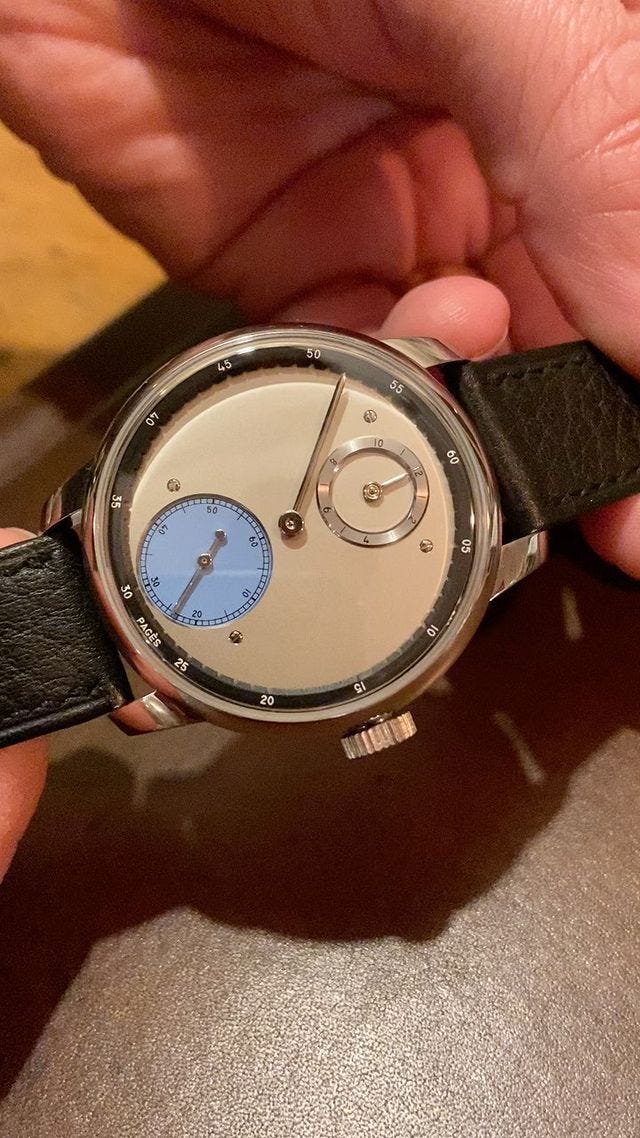Week in Watches: Releases from King Seiko, Audemars Piguet, and Zenith
A closer look at independent watchmaker Raúl Pagès Régulateur à Détente
A ton of new releases this week, more than any one newsletter can reasonably keep up with. I wrote up just one release that seems to have flown under the radar from an extremely talented independent Swiss watchmaker who makes 4-5 watches a year. After that, we’ll take a look at the week in releases from the big brands.
Week in Watches is a weekly newsletter with the biggest news in watches, but fun. To get it delivered straight to your inbox every week, subscribe now:
Introducing: Raúl Pagès Régulateur
An amazing technical achievement from the independent Swiss watchmaker. [Click the link above for the full intro post.]
Now this is the kind of release I can get excited about. Independent Swiss watchmaker Raúl Pagès has introduced his third project, the Régulateur à Détente RP1.
Before we get to the new watch, a quick introduction to Raúl. For the past 15 years, he’s been a watchmaker focused on restoring movements for some of the biggest names in watches. In 2006 he started in the restoration department of Parmigiani before moving to work on restorations for the Patek Philippe Museum.
In 2012, he struck out on his own, setting up his workshop to design and handcraft his own timepieces. He started with the Tortue automaton, comprised of 352 pieces made entirely by Pagès’ hands (Torture video). Then in 2016, he produced his first wristwatch, a limited series of 10 pieces, the Soberly Onyx. which featured a restored vintage Cyma pocket watch movement.
Now 39 years old, Pagès is back with his second wristwatch, the Régulateur à Détente RP1.
The Régulateur à Détente is designed and handcrafted by Pagès in his Les Brenets, Switzerland workshop. The utmost attention to detail has been paid to the dial, case, and most importantly, the in-house movement. Let’s take a look at each, starting with the amazing technical achievement of the new caliber.
What the hell is a detent escapement and why should I care?
The caliber is the first major piece of news here. It’s equipped with a pivoted detent escapement. Here’s what you need to know about the detent escapement: it’s basically the perfect escapement in theory. Unlike the typical lever escapement seen in pretty much any modern wristwatch, there is no lever, which means there is no sliding friction. Instead, the escape wheel delivers an impulse directly to the balance wheel, which means the escapement does not need to be oiled.

In principle, this means the detent escapement is more stable and more precise. As such, you’ll often see it referred to as a “chronometer escapement.” It was often used in marine chronometers on ships, where accurate timekeeping was essential for navigation.
But here’s the problem: the detent escapement isn’t shock-resistant, which is why it was used in ships, where it could be placed in a big box to avoid shock, but it was never really adopted in wristwatches.
Pagès says his new caliber featuring a detent escapement is “doubly in-house,” both designed and handmade by him. To solve the shock resistance problem inherent in the detent escapement, Pagès developed a patented system that prevents the escape wheel from leaving the rest position when the watch is shaken.
Here’s a fun video of Pagès illustrating the shock resistance on Instagram:
According to Pagès, designing and developing the new caliber took about three years.
Listen, not that many shops are producing a detent escapement to begin with nowadays. Urban Jurgensen lays claim to developing the first detent escapement for a wristwatch, courtesy of Derek Pratt and Peter Baumbarger (and by the way, that was only 10 years ago, so this is still a new advancement). To finish each component by hand takes it to another level. Each of the 171 components of the movement is hand-finished — beveled, polished, satin-finished, or circular-grained — by Pages.
A Le Corbusier-inspired regulator dial

The precision of the detent escapement caliber is matched by Pagès’ choice of display: the regulator. It’s a traditional display, giving each of the hands their own space.
But Pagès gave the regulator dial a modern twist, adapting colors from the famous Swiss architect Le Corbusier. The blue subdial is a bright “cerulean blue 59” for those keeping tabs on their pantones. The black outer hour ring beautifully circles the dial and has diamond polished edges. The handmade hands are sleek and polished. All of the elements seem to come together to give the dial interest and depth.
Meanwhile, the stainless steel case is refined and modern, a manageable 38.5mm. The top of the lugs, bezel, and caseback are polished, while the middle case is satin-finished to offer a bit of contrast. In a bit of a wink to marine chronometers, Pagès screws the lugs into the mid-case.
Bringing it together
As some collectors said in my year-in-review piece on A Collected Man, 2021 was “the year of independents.” Some went so far as to suggest this will be the decade of independents.
But with so many of the independents becoming household names and achieving headline-grabbing prices, I’m most excited by new or relatively unknown watchmakers. That was the case when I chatted with Petermann Bedat in 2020.
Like Gabriel Petermann, Raúl Pagès had a background in restoring vintage timepieces before opening his own workshop. The vision these watchmakers have to adapt traditional watchmaking techniques with a flourish of modernity is something that truly excites me, and I hope we continue to see more of it.
In a hobby overrun with hype and high prices, it’s these corners of watchmaking that keep me coming back.
The new Régulateur à Détente costs CHF 85,000. It is not a numbered limited series, but Pagès says that because the watch is entirely crafted by hand, he can only produce 4-5 a year. For more information, visit Raúl Pagès website.
Select specs: Manual wind in-house caliber beating at 18,000 vph featuring a pivoted detent escapement, 47-hour power reserve, 17 jewels and 171 total components. The stainless steel case measures 38.5 mm x 10.2 mm (with sapphire crystal) x 19mm lug width.
Audemars Piguet releases its slate of 50th anniversary Royal Oaks
I probably don’t need to tell you about the slate of new Royal Oak releases from Audemars Piguet. Ben Clymer introduced us to the new “Jumbo” ref. 16202. It stays pretty true to the classic Jumbo (“if it ain’t broke,” and all that), but makes updates where due, most notably by updating the caliber and adding a quickset date.
For me, the mid-size Royal Oak options have always been the perfect fit, and I like that the new 37mm models make a few aesthetic changes to bring it in line with the Jumbo. And the way prices for the mid-size references from the 80s-90s have gone up in the past couple of years, it might be more feasible to try and cop a new reference 15550 than a neo-vintage Royal Oak nowadays (the ref. 15550 starts at $24,100 in steel).
I took some time to look back on how AP has celebrated previous Royal Oak releases. Of course, there’s the 20th anniversary “Jubilee” Royal Oak, a limited edition of 1,000 watches designed as a faithful homage to the original Royal Oak. Of those 1,000 examples, it’s estimated only 200-300 are fitted with a gorgeous salmon dial. Phillips just sold a salmon example for $302k in December.
Much rarer than the salmon Jubilee Royal Oak is the platinum 125th Anniversary Royal Oak 14802PT from 2000. This Royal Oak is almost mythical among collectors — only 8 examples exist. As the story goes, for its 125th anniversary AP planned to release a limited run of 125 Royal Oaks in platinum, a first for the model. However, due to the high cost of production, the general lack of demand from AP's authorized dealer network for 125 (super expensive) time-only platinum watches, and the burst of the dot-com bubble around the same time, the watches were never completed.

Only 8 watches were ever finished and quietly sold off. You can even tell they're incomplete by looking at the caliber 2120 through the caseback: the movements aren't decorated. It's a fascinating watch from the Royal Oak's history, and man, I'd love to put it on my wrist — the platinum watch and bracelet weighs about half a pound.
Much of the detail of this story come from a Timezone post by William Massena from 2011, a more innocent time when a 14802PT was posted for sale on the forum for the humble price of $49k.
Back to the new Royal Oak though: in all, Audemars Piguet released 42 (!) new Royal Oak references. Time and Tide did a good job summarizing the onslaught.
WHAT DID SEIKO RELEASE THIS WEEK?
King Seiko returns with a vintage-inspired lineup
From Worn & Wound:
“What we have [from King Seiko] are five new watches, all modeled after the original King Seiko KSK. Yes, so was an earlier limited edition from 2020, but these new releases are more directly vintage-inspired in size and proportion, coming in at just 37mm in diameter (and 12mm thick) with case lines that mimic the original a little more closely than the 2020 LE. The lug profile appears to be exactly the same, and the bracelet is a modern recreation of the vintage style that was common on original King Seiko references.”
Vintage King Seiko remains one of the best buys in vintage watches, and Seiko kept this release faithful to the original: same case profile, 37mm diameter, Seiko 6R31 caliber, and a bracelet that re-interprets the original.
When I tried on a vintage King Seiko (the one above) for the first time last year, I was surprised how much I liked it on wrist. The bracelet and thick, faceted lugs make it feel sportier than you’d think by looking at photos. The lugs reminded me of those bold Enicar Sherpa lugs, and I remember calling the King Seiko a “dressed up Enicar.”
King Seiko was basically launched by Seiko in the 60s as a competitor to Grand Seiko, setting up a separate factory to facilitate a little healthy familial competition. It’s a great brand with an interesting history, so it’s exciting to see Seiko committed to keeping the name alive. The new King Seiko line has an MSRP of $1,700.
👨❤️💋👨Go deeper: I love that this business podcast did a deep dive on the history of the competition between King Seiko and Grand Seiko.
Grand Seiko. Meanwhile, it’s the third episode of Week in Watches, and it’s the third week Grand Seiko announced a slate of new watches. This time ‘round, it’s two more limited editions (both limited to 550 pieces), to celebrate the 44GS’s 55th anniversary. See the online press release from Grand Seiko.
THROUGH THE WIRE
There were a ton of other releases this week too: 🌃 the Zenith Defy Skyline is an interesting new steel, integrated bracelet option; 🌈 the Defy 21 Chroma is a literal rainbow of colors. 🐍 This new Bulgari Serpenti holds a secret watch in its mouth and had me hissing i’m a snaaaaaaake (just click it and reminescence on the hayday of 2010s YouTube) all week long.
🎤 The most amazing fact from the amazing Ed Sheeran-Hodinkee interview is that the man hasn’t carried a phone since 2015. “Shape of You” hadn’t even come out yet!
I finally got around to reading Jack Forster’s “Have Price and Quality Filed for Divorce in Luxury Watchmaking?” He stops short of answering the question explicitly, but his turn of phrase to close the article slaps especially hard:
“I long, maybe foolishly, for the days when "luxury" was luxury of craft, time, and materials.
There is nothing like an obsession with money to make luxury start to look cheap.”
In Chicago: Actor Michael Shannon on why Chicago bars are “worth the trouble”
Week in Watches is a weekly newsletter with the biggest news in watches, but fun. To get it delivered straight to your inbox every week, subscribe now:











